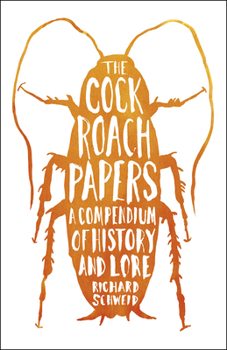The Cockroach Papers: A Compendium of History and Lore
What has six legs, skulks around late at night, and likes to sniff out the hidden crevices, the dank corners, and the dark recesses? The cockroach, of course. The cockroach is a bug of great design.... This description may be from another edition of this product.
Format:Paperback
Language:English
ISBN:022626047X
ISBN13:9780226260471
Release Date:June 2015
Publisher:University of Chicago Press
Length:208 Pages
Weight:0.43 lbs.
Dimensions:0.3" x 5.4" x 8.4"
Customer Reviews
4 ratings
I Still Step On Them!
Published by Thriftbooks.com User , 17 years ago
I read this book while spending the summer in a run-down, cockroach-infested, seasonal fishing cabin in Canada. It was hilarous, informative, very, very well-written and almost (almost) made me like the nasty little things. I always read while eating lunch, but really, don't do that with this book! I highly recommend this to anybody who has an interest in nature, an interest in insects, a curious mind, or...a population of cockroaches in his house! (No, really; there was enough info in this book to help me understand The Enemy and largely eradicate them. I am now in the market for similar books on bats, mice, ants, and bears... .)
Excellent human and natural history of the cockroach
Published by Thriftbooks.com User , 19 years ago
_The Cockroach Papers_ by Richard Schweid is a book one might not normally think of as enjoyable, one that that focuses on the biology and human history of the cockroach. I however found it very entertaining, even funny at times, and also extremely informative and boasting a wealth of illustrations. The author had an engaging writing style, weaving in stories of his personal life (some only marginally related to cockroaches, though all were quite engrossing). There are a great variety of roach species in the world, though not all of them are pests. The most famous of course are the pest species, including the most common domestic cockroach in the U.S, the German cockroach, (_Blattella germanica_), and the second most common, the American cockroach (_Periplaneta americana_), both the main subjects of the book. Other pest species in North America include the oriental cockroach, brown-banded roach (noted for colonizing appliances), and the smokey-brown, though there are 64 other species on the continent far from the haunts of man. More than 5,000 species of cockroach are known in the order Blattaria (from the Greek word blattae, for roach). Only about a hundred species worldwide occur around humans at all; most live unseen, generally in hot humid jungles though they are found virtually everywhere on Earth. Schweid went into a great deal of detail exploring roach anatomy, physiology, pheromones (including not only mating pheromones but interestingly aggregation and dispersal pheromones), daily habits, and mating behavior, much of it fascinating reading. One learns the early warning system for roaches is not their antennae; it is a pair of feelers called the cerci, located on the backside near the anus, covered in hundreds of remarkably fine and sensitive hairs, each only 0.5 millimeters long and 0.005 millimeters wide (this is what lets them scurry away so fast when the lights come on!). Roaches have had a long history with humanity, traveling with humans to every spot on the globe. They were particularly fond of traveling by ship, and historical records have shown people such as the Sir Francis Drake, Captain Bligh, and others having contended with them. Interesting, the word cockroach itself is a relative newcomer; while they have long been known to humanity (the Romans for instance called them lucifuga, for their habit of avoiding light), the word did not appear until Europeans began traveling the world. "Cockroach" as a term first appeared in the 1500s to describe not long familiar pests but new ones noticed from sojourns in Africa and elsewhere (the first written use in the English language came from Captain John Smith of Pocahontas fame in 1624). The two most famous in the U.S. are not natives; the German cockroach is thought native to north Africa, spread by the Phoenicians to Europe and then from there throughout Russia and eventually the Americas, while the American cockroach (sometimes euphemistically called the "water bug") is tho
A Much-Maligned Evolutionary Wonder
Published by Thriftbooks.com User , 21 years ago
OK, I admit I used to be among the majority who reacted in revulsion to these creatures and whose first instinct was to squash it--quickly!Reading Schweid's fascinating book changed all that. The highly adaptable cockroach will probably outlive humans. They're perfectly designed scavengers and extremely good at proliferating their species.The book combines a mixture of fact, anecdotes and fictional excerpts that explore the nature & habits of the cockroach as well as its uneasy relationship with humanity.One of a selective number of books I actually had to buy. And, as a footnote, on a recent trip to D.C., I went to the Smithsonian and held a giant Madgascar hissing cockroach. And I like it!
Fascinating
Published by Thriftbooks.com User , 24 years ago
There are fascinating random factoids on nearly every page. My coworkers and most friends don't care to hear all my new knowledge, unfortunately. Not exactly cocktail party chitchat. But extremely interesting to learn about. Mating habits, nervous systems, favorite foods, pheromones,molting, it's all here!





